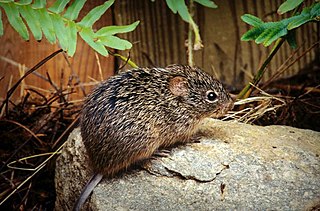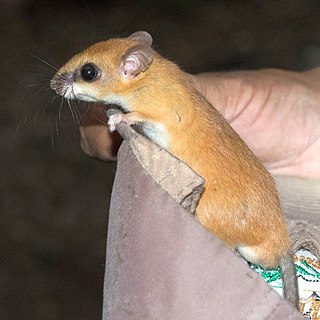
The rodent subfamily Sigmodontinae includes New World rats and mice, with at least 376 species. Many authorities include the Neotominae and Tylomyinae as part of a larger definition of Sigmodontinae. When those genera are included, the species count numbers at least 508. Their distribution includes much of the New World, but the genera are predominantly South American, such as brucies. They invaded South America from Central America as part of the Great American Interchange near the end of the Miocene, about 5 million years ago. Sigmodontines proceeded to diversify explosively in the formerly isolated continent. They inhabit many of the same ecological niches that the Murinae occupy in the Old World.

Oryzomys nelsoni is an extinct rodent of María Madre Island, Nayarit, Mexico. Within the genus Oryzomys of the family Cricetidae, it may have been most closely related to the mainland species O. albiventer. Since its first description in 1898, most authors have regarded it as a distinct species, but it has also been classified as a mere subspecies of the marsh rice rat (O. palustris).

Oryzomys is a genus of semiaquatic rodents in the tribe Oryzomyini living in southern North America and far northern South America. It includes eight species, two of which—the marsh rice rat (O. palustris) of the United States and O. couesi of Mexico and Central America—are widespread; the six others have more restricted distributions. The species have had eventful taxonomic histories, and most species were at one time included in the marsh rice rat; additional species may be recognized in the future. The name Oryzomys was established in 1857 by Spencer Fullerton Baird for the marsh rice rat and was soon applied to over a hundred species of American rodents. Subsequently, the genus gradually became more narrowly defined until its current contents were established in 2006, when ten new genera were established for species previously placed in Oryzomys.

Oecomys trinitatis, also known as the long-furred oecomys, long-furred rice rat, Trinidad arboreal rice rat, or big arboreal rice rat, is a species of rodent in the genus Oecomys of family Cricetidae. As currently constituted, it has a wide distribution in Central America and South America, being found in southern Costa Rica, Panama, Colombia, Venezuela, Trinidad and Tobago, Guyana, Suriname, French Guiana, much of Brazil, eastern Ecuador, and eastern Peru.
Oligoryzomys magellanicus, also known as the Patagonian colilargo and the Magellanic pygmy rice rat, is a species of rodent in the genus Oligoryzomys of the family Cricetidae. It is found in the southernmost parts of Argentina and Chile, including Tierra del Fuego and other outlying islands. Its karyotype has 2n = 54 and FNa = 66.

Oligoryzomys vegetus, also known as the sprightly colilargo or sprightly pygmy rice rat, is a species of rodent in the genus Oligoryzomys of family Cricetidae. It is found only in the mountains of Costa Rica and western Panama.
Oreoryzomys balneator, also known as the Peruvian rice rat or Ecuadoran oryzomys, is a species of rodent in the tribe Oryzomyini of family Cricetidae. It is found in Ecuador and northern Peru in cloud forest at elevations from 1500 to 1800 m. It is the only species in the genus Oreoryzomys, which was included in Oryzomys until 2006. The genus name Oreoryzomys is a combination of ορος the Greek word for "mountain" with the old genus name Oryzomys and refers to the mountainous habitat of O. balneator. Recent research suggests that O. balneator is not closely related to Oryzomys, but instead is probably related to Microryzomys within a clade also including Neacomys and Oligoryzomys.

Nephelomys devius, also known as the Talamancan oryzomys, Boquete rice rat, Chiriqui rice rat, or montane rice rat, is a species of rodent in the genus Nephelomys of family Cricetidae. It is found in cloud forest in the highlands of Costa Rica and western Panama.

Oryzomys dimidiatus, also known as the Nicaraguan oryzomys, Thomas's rice rat, or the Nicaraguan rice rat, is a rodent in the family Cricetidae. It is known from only three specimens, all collected in southeastern Nicaragua since 1904. Placed in Nectomys upon its discovery, it was later classified in its own subgenus of Oryzomys and finally recognized as closely related to other species now placed in Oryzomys, including the marsh rice rat and Coues' rice rat, which occurs in the same region.

The Galápagos rice rat, also known as the Galápagos oryzomys, is a species of rodent that is endemic to the Galápagos Islands.

Oryzomys gorgasi, also known as Gorgas's oryzomys or Gorgas's rice rat, is a rodent in the genus Oryzomys of family Cricetidae. First recorded in 1967, it is known from only a few localities, including a freshwater swamp in the lowlands of northwestern Colombia and a mangrove islet in northwestern Venezuela. It reportedly formerly occurred on the island of Curaçao off northwestern Venezuela; this extinct population has been described as a separate species, Oryzomys curasoae, but does not differ morphologically from mainland populations.

Mindomys hammondi, also known as Hammond's rice rat or Hammond's oryzomys, is an endangered species of rodent in the tribe Oryzomyini of family Cricetidae. Formerly considered to be related with Nectomys, Sigmodontomys, Megalomys, or Oryzomys, it is now placed in then genus Mindomys, but its relationships remain obscure; some evidence supports a placement near Oecomys or as a basal member of Oryzomyini.
The Colombian rice rat, also known as the white-footed Handley's mouse is a species of rodent in the family Cricetidae occurring only in Colombia. It was previously included in Oryzomys, but closely resembles the dusky montane rat, and accordingly both species were placed in the new genus Handleyomys in 2002.
Nephelomys keaysi, also known as Keays's oryzomys or Keays's rice rat, is a species of rodent in the genus Nephelomys of family Cricetidae. It is found from southeastern Peru to northern Bolivia on the eastern slope of the Andes in Yungas humid forest at altitudes of 1000 to 2600 m. Although its continued existence is not in serious danger and it is listed as "least concern", destruction of its habitat may pose a threat to some populations.

Hatt's vesper rat, also known as Hatt's vesper mouse or Yucatán vesper rat, is a species of rodent in the family Cricetidae. It is the only species in the genus Otonyctomys. It is named for its discoverer, Robert T. Hatt.
Sigmodontomys alfari, also known as the short-tailed sigmodontomys, Alfaro's rice water rat, Cana rice rat, or Allen's rice rat, is a species of rodent in the subfamily Sigmodontinae of family Cricetidae. It is found from Honduras through Nicaragua, Costa Rica, and Panama into South America, where it occurs from Venezuela through Colombia to Ecuador.
Sigmodontomys is a genus of rodent in the tribe Oryzomyini of family Cricetidae. It is related to Nectomys and Melanomys and used to be included in Nectomys. It includes two species, Sigmodontomys alfari and the much rarer Sigmodontomys aphrastus, but whether these are indeed each other's closest relatives is uncertain.
Nephelomys moerex is a species of rodent in the genus Nephelomys of family Cricetidae. The type locality is at Mindo in western Ecuador, where it has been recorded together with three other rodents of the oryzomyine group, Sigmodontomys aphrastus, Mindomys hammondi, and Handleyomys alfaroi, as well as three opossums, Chironectes minimus and unidentified species of Didelphis and Marmosa. Mindo is a "tiny agricultural community" located at 0°02'S, 78°48'W and 1,264 metres (4,150 ft) above sea level. It was originally described by Oldfield Thomas as a subspecies of Oryzomys albigularis. It remained synonymized under this species until it was recognized as a separate species when the genus Nephelomys was established for Oryzomys albigularis and related species in 2006.
In mammals, ungual tufts are tufts of hairs at the base of claws of the forefeet and hindfeet. Their presence has been used as a character in cladistic studies of the Cricetidae, a large family of rodents.
Tanyuromys is a genus of oryzomyine rodents distributed in mountainous areas from Central America to the western part of South America. The species in this genus have historically been placed in Sigmodontomys, but according to cladistic research, this genus is either sister to the clade containing Sigmodontomys and Melanomys or sister to the extinct Caribbean giant rice rat Megalomys. Along with members of Aegialomys and Melanomys, it occurs at some of the highest elevations known for oryzomines.











